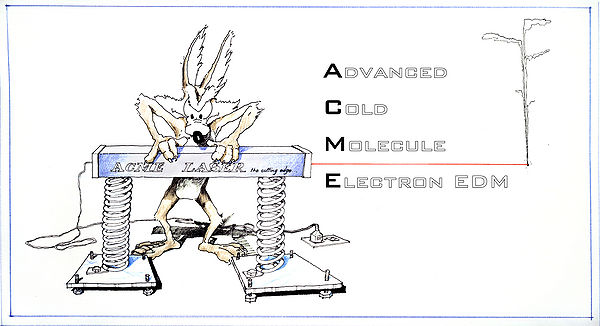ThO
ACME Thorium Oxide Electron EDM Experiment
ACME (Advanced Cold Molecule Electron EDM) Collaboration:
- DeMille Group (Yale): Brendon O'Leary, Adam West, Dave DeMille
- Doyle Group: Nick Hutzler, Elizabeth Petrik, Jacob Baron, John Doyle
- Gabrielse Group (Harvard): Ben Spaun, Paul Hess, Cris Panda, Gerald Gabrielse
Former Members: Max Parsons (B.S., Harvard 2010), Yulia Gurevich (Ph.D., Harvard 2011), Amar Vutha (Ph.D., Yale 2011), Ivan Kozyryev (B.S., Yale 2011), Emil Kirlov (Postdoc)
Click here for the ACME Collaboration website
Publications
- Proposal for the experiment: Search for the electric dipole moment of the electron with thorium monoxide. A.C. Vutha, W.C. Campbell, Y.V. Gurevich, N.R. Hutzler, M. Parsons, D. Patterson, E. Petrik, B. Spaun, J.M. Doyle, G. Gabrielse and D. DeMille. Journal of Physics B 43 074007 (2010). (arXiv)
- A study of our molecular beam: A cryogenic beam of refractory, chemically reactive molecules with expansion cooling. N. R. Hutzler, M. Parsons, Y. V. Gurevich, P. W. Hess, E. Petrik, B. Spaun, A. C. Vutha, D. DeMille, G. Gabrielse, J. M. Doyle. Phys. Chem. Chem. Phys., 2011, 13, 18976-18985.
- Measurement of magnetic and electric dipole moments in the EDM state of ThO: Magnetic and electric dipole moments of the ^3\Delta_1 state in ThO. A. C. Vutha, B. Spaun, Y. V. Gurevich, N. R. Hutzler, E. Kirilov, J. M. Doyle, G. Gabrielse, D. DeMille. Phys. Rev. A 84, 034502 (2011)
Overview
The ACME experiment will use a cryogenic molecular beam of the heavy polar molecule ThO to attempt a measurement of the electron's electric dipole moment (EDM). The existence of an electron EDM would manifest itself as very small energy shifts in certain molecular states when the molecules are in an electric field. These energy shifts are proportional to the electric field and flip sign when the electric field is reversed, so by flipping the electric field and observing the energy levels change, we hope to determine the size of the electron's EDM.
The molecular beam is is created by buffer gas cooling an ablated sample of ThO, which then flows out of an orifice. The molecules will enter a magnetically shielded vacuum chamber that contains uniform electric and magnetic fields. We will optically pump the molecules into the "H" electronic (EDM sensitive) state, and then polarize them by optically pumping undesired polarizations out of the H state. The molecules will then precess in the fields, and we will read out the accumulated phase with polarized lasers. By reversing the electric field, we can reverse the amount of precession accumulated from the electron EDM; taking the difference between these two phases yields the electron EDM.
This idea is the basis for any permanent EDM search, whether it is for atoms, neutrons, or electrons, however our experiment has several features that will enhance our sensitivity:
- Polar Molecule. Polar molecules have the highest known sensitivity to an electron electric dipole moment. The electric field inside a polar molecule can be as large as tens of gigavolts per centimeter, almost a million times larger than any controlled field that can be created in a laboratory. Because the energy of a dipole moment in an electric field is proportional to the field strength, the electrons orbiting a polar molecule can experience these large fields and give proportionally larger energy shift. The electric field in ThO has been calculated to be over 100 GV/cm, the largest of any known molecule.
- Internal Co-magnetometer. One of the largest systematic limitations to EDM searches is the creation of stray electric and magnetic fields. Since we try to measure tiny energy splittings, a small stray magnetic field can could destroy our signal, or worse, look like an EDM signature if the magnetic field direction reversed with the electric field reversal. This could happen, for example, from leakage currents between the electric field plates. Our molecule has a parity doublet: two close-lying (roughly tens of kilohertz in zero field) states of opposite parity in the ground rotational level of the H state. In addition to allowing complete polarization of the molecule in very weak fields, the two components of this doublet have opposite shifts from an electron EDM. In other words, the two different doublet states roughly correspond to spectroscopically reversing the internal electric field experienced by the electron. Therefore, we can perform our field reversal without reversing any external fields, which will give us very powerful rejection of systematic errors. Other limiting systematics, such as geometric phases, can also be eliminated because they do not reverse between populating the different doublets.
- Cryogenic Beam Source. Our beam will be a hydrodynamically enhanced buffer gas cooled beam, which is a technology that has demonstrated high-flux, forward-peaked beams that are cold vibrationally, rotationally, and translationally (in the beam frame). We beams of ThO with time-averaged fluxes over 10^13 molecules/state/second moving with a forward velocity of 170 m/s, and an internal temperature of 4 K, without the need for stark deceleration.
Funding
We would like to thank the National Science Foundation (NSF) and the National Institute of Standards and Technology (NIST) for funding our experiment.

